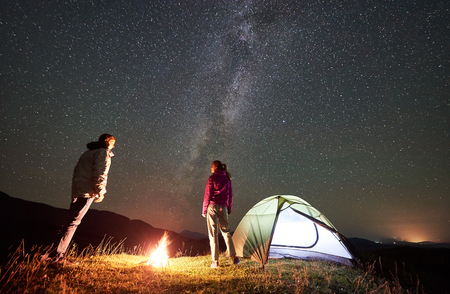1. Introduction: Why Waste Reduction Matters
When it comes to camping in the United States, whether you’re pitching a tent in a bustling city park or trekking deep into the wilderness, reducing waste is more important than ever. Camping offers an incredible way to connect with nature and escape daily routines, but it also comes with a responsibility to protect the environment for future generations. Minimizing waste while camping not only preserves the beauty of natural spaces but also helps reduce pollution and human impact on fragile ecosystems. However, the strategies for waste reduction can look very different depending on where you set up camp. Urban camping sites often provide amenities like trash bins, recycling options, and access to stores, making it easier to manage waste responsibly. In contrast, backcountry camping usually requires campers to pack out everything they bring in—there are no facilities, and every piece of trash must be carried home. Understanding these differences is key to ensuring your camping trip leaves no trace, regardless of the environment.
Understanding Urban Camping Environments
Urban camping offers a unique experience, blending the adventure of spending nights outdoors with the convenience of city amenities. Unlike backcountry sites, urban campgrounds are typically situated within or near metropolitan areas, such as city parks, greenways, or even rooftops. This proximity to civilization brings certain comforts but also introduces distinct challenges—especially when it comes to managing and reducing waste.
Typical Amenities in Urban Campgrounds
| Amenity | Description | Waste Implications |
|---|---|---|
| Restrooms & Showers | Often available and regularly maintained by municipal staff. | Leads to less need for portable hygiene products but creates more restroom paper and packaging waste. |
| Trash & Recycling Bins | Conveniently located throughout most urban campgrounds. | Encourages proper sorting but may still see contamination from food wrappers and single-use plastics. |
| Food Vendors & Nearby Stores | Easy access to snacks, groceries, and takeout options. | Increases packaging waste and single-use containers. |
| Public Transportation Access | Enables campers to travel light and reduce vehicle emissions. | No direct impact on campsite waste but supports overall sustainability. |
Types of Waste Generated in Urban Settings
The nature of urban camping means campers are more likely to produce:
- Single-use packaging: From takeout meals or convenience store items.
- PET bottles and cans: Due to easy access to vending machines and stores.
- Papertowels, napkins, and wipes: Given the availability of public restrooms and food vendors.
- Disposable utensils: Often provided by food vendors or fast-casual restaurants nearby.
Initial Strategies for Waste Reduction in Urban Campsites
- Bring Reusables: Pack reusable utensils, water bottles, coffee mugs, and shopping bags to cut down on disposables offered by local businesses.
- Plan Meals Ahead: Prepare simple meals at home to minimize reliance on packaged foods or takeout during your stay.
- Sort Waste Properly: Take advantage of provided recycling bins by separating recyclables from landfill trash. Look for composting options if available.
- Avoid Excess Packaging: When shopping for supplies, choose products with minimal or recyclable packaging, and buy in bulk when possible.
- Civic Engagement: Support local efforts for greener campsites by participating in clean-up events or advocating for better waste management infrastructure in city parks.
The combination of accessible amenities and the challenges of high foot traffic make waste reduction both easier to start and crucial for maintaining clean, enjoyable urban camping spaces. With mindful preparation and responsible habits, campers can significantly minimize their environmental footprint—even in the heart of the city.

3. Understanding Backcountry Camping Environments
Backcountry camping offers a unique experience far removed from the conveniences and infrastructure of urban settings. In these remote, natural environments, the principles of “Leave No Trace” aren’t just encouraged—they’re essential. The challenges here are significant: there are no waste bins, trash pickup services, or public facilities. Campers must take full responsibility for managing everything they bring in, including all forms of waste. This means packing out all trash, leftover food, and even biodegradable items that might disrupt local ecosystems.
The opportunities for waste reduction in backcountry environments stem from thoughtful planning and a minimalist mindset. Campers often adopt strategies like repackaging food into reusable containers to minimize single-use plastics, choosing lightweight gear to reduce overall load, and bringing multi-purpose items to cut down on unnecessary supplies. Composting is generally not feasible due to wildlife concerns and ecosystem preservation; instead, the focus shifts to reducing organic waste before leaving home.
Ultimately, backcountry campers become stewards of the land by adhering strictly to “Leave No Trace” practices. This ethos not only protects pristine wilderness but also sets a standard for future outdoor enthusiasts. By embracing the challenges and seizing the opportunities for waste reduction in these untouched environments, campers help ensure that America’s wild spaces remain unspoiled for generations to come.
4. Waste Reduction Essentials: Gear & Packing
Whether you’re planning a weekend in a city campground or heading deep into the backcountry, minimizing waste starts long before you pitch your tent. Smart packing and gear choices can make a big difference in how much trash you generate—and how much you have to haul out. Below are some practical tips and recommended essentials that work for both urban and remote camping environments.
Choose Reusable Over Disposable
Single-use items are the number one source of campsite waste. Opt for sturdy, reusable gear that lasts season after season. Here’s a comparison of common options:
| Item | Reusable Option | Disposable Alternative |
|---|---|---|
| Plates & Utensils | Stainless steel or bamboo sets | Paper/plastic plates, cutlery |
| Cups & Bottles | Insulated stainless bottles, silicone cups | Single-use water bottles, red cups |
| Food Storage | Silicone zip bags, nesting containers | Plastic zipper bags, cling wrap |
| Cleaning Supplies | Microfiber cloths, solid soap bars | Paper towels, liquid soaps in plastic bottles |
| Towels/Napkins | Packed microfiber towels, cotton napkins | Paper napkins/towels |
Pack Smart: Pre-Trip Food Prep & Portioning
Avoid hauling excess packaging and food waste by prepping meals at home. Portion dry goods into reusable containers and chop veggies ahead of time to minimize what needs to be discarded on-site. For urban campers with access to grocery stores, pre-planning means fewer impulse purchases in single-use packaging.
Tips for Both Environments:
- Bulk Up: Buy snacks and ingredients in bulk to avoid individual wrappers.
- Decant Liquids: Transfer cooking oils and sauces into small reusable bottles.
- No-Cook Meals: Consider simple meals that require less packaging and clean-up.
- Personal Hygiene: Bring refillable soap and shampoo containers; pack a quick-dry towel instead of wet wipes.
- Coffee & Tea: Use a French press mug or pour-over filter instead of single-serve pods or disposable tea bags.
Select Multi-Use Items Whenever Possible
The best waste-reducing gear does double duty. Think bandanas (towel, potholder, napkin), lightweight nesting cookware sets, and collapsible buckets for washing dishes or carrying water. The less you carry—and the less you throw away—the easier it is on both you and the environment.
Packing Checklist for Waste Reduction:
- Reusable water bottle and mug (insulated preferred)
- Nesting cookware set with reusable utensils
- BPA-free food storage containers or silicone bags
- Pocket-sized trash bag for pack-in/pack-out (urban campsites may provide bins, but always be prepared)
- Microfiber towel and cloths for cleaning up spills or drying dishes
- Lighter-weight cutting board and knife (instead of disposables)
- Sustainable toiletries (solid bar soap/shampoo, bamboo toothbrush)
- Pouch or dry bag to store all waste until properly disposed of offsite
The bottom line? By making conscious choices before you leave home, you’ll set yourself up for a lower-impact adventure—whether your campsite is under city lights or starlit skies.
5. On-Site Strategies: Reducing, Reusing, and Disposing Responsibly
Whether you’re camping in an urban park or deep in the backcountry, adopting smart waste habits on-site is key to minimizing your environmental impact.
Managing Food Waste
Plan your meals carefully to avoid excess and pack perishable items in reusable containers. For urban camping, separate food scraps for local composting if available, while in the backcountry, collect all organic waste in sealable bags and pack it out—don’t bury it or leave it for wildlife. Avoid single-use snack wrappers by portioning food ahead of time into reusable bags.
Smart Packaging Choices
Choose products with minimal packaging and favor bulk options when prepping for your trip. At camp, flatten and consolidate recyclable materials to save space and make transporting them easier. In cities, use nearby recycling bins; in remote areas, carry out all recyclables until you reach proper facilities.
Water Use and Greywater Disposal
Conserve water by bringing a collapsible basin for dishwashing and using biodegradable soap sparingly. For urban sites, utilize designated greywater disposal stations. In wilderness settings, strain food particles from wash water and scatter it at least 200 feet from water sources, trails, and campsites to reduce contamination risks.
Sanitation Solutions
Urban campers should use provided restrooms or portable toilets and follow posted disposal instructions. Backcountry campers must be prepared with trowels or wag bags for human waste—bury solid waste at least six inches deep and 200 feet away from water sources, or pack it out where required. Always pack out used toilet paper or hygiene products in sealed bags.
Reuse Before You Toss
Get creative with leftovers—repack containers for multiple uses and repurpose empty jars or bottles as storage. This reduces both trash volume and the need to bring extra gear.
Leave No Trace—Everywhere
No matter where you pitch your tent, the Leave No Trace principle applies: If you packed it in, pack it out. By actively reducing, reusing, and disposing of waste responsibly on-site, you help keep both city parks and wild spaces clean for everyone.
6. Community Impact and Responsible Camping Culture
Camping is not just a personal adventure; it shapes the health and character of entire communities—whether you’re pitching a tent in an urban park or deep in the backcountry. Every choice campers make about waste, from what they pack in to how they dispose of trash, influences local ecosystems and the experiences of fellow outdoor enthusiasts. In urban camping areas, improper waste disposal can strain city resources, disrupt wildlife, and even discourage future public access to green spaces. Meanwhile, careless habits in remote areas can lead to pollution that lingers for decades, harming fragile environments and diminishing the sense of wildness that draws people out in the first place.
Building a responsible camping culture means recognizing this ripple effect and committing to actions that leave a positive mark. Simple steps—like separating recyclables, using established waste stations, or packing out everything brought in—help preserve natural beauty and community goodwill. When campers model good stewardship, it encourages others to follow suit, creating a cycle where responsible habits become the norm rather than the exception.
Campers can further support local communities by respecting posted rules, volunteering for clean-up events, and sharing best practices with newcomers. Ultimately, fostering a culture of responsibility isn’t just about minimizing your own impact—it’s about helping everyone enjoy America’s diverse outdoor spaces safely and sustainably for generations to come.
7. Conclusion: Choosing Waste-Wise Habits for Every Camping Trip
Whether you’re pitching a tent in an urban campground or venturing deep into the backcountry, adopting waste-wise habits makes a meaningful difference for both the environment and your fellow outdoor enthusiasts. Urban camping offers more amenities but also more temptations to create unnecessary waste, while backcountry trips demand that you pack out everything you bring in. No matter where you camp, planning ahead—such as choosing reusable gear, minimizing packaging, and understanding local waste disposal rules—ensures your trip leaves a lighter footprint. Remember to always follow Leave No Trace principles, separate recyclables, compost when possible, and share your sustainable practices with others. By consistently applying these waste reduction strategies on every adventure, you help protect natural spaces and set a positive example. Make mindful choices part of your camping tradition, and inspire others to join you in caring for our wild places—urban or remote—for generations to come.


